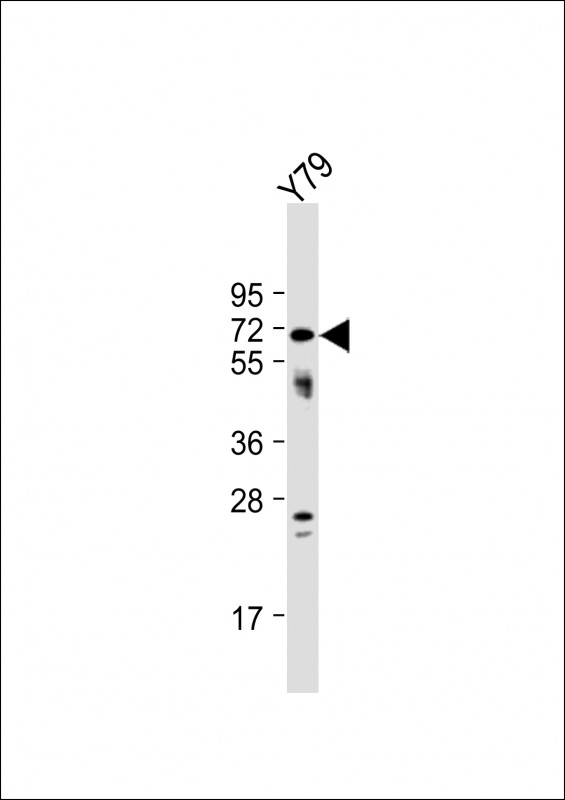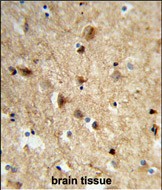NEURL Antibody (Center)
Affinity Purified Rabbit Polyclonal Antibody (Pab)
- SPECIFICATION
- CITATIONS
- PROTOCOLS
- BACKGROUND

Application
| IHC-P, WB, E |
|---|---|
| Primary Accession | O76050 |
| Reactivity | Human |
| Host | Rabbit |
| Clonality | Polyclonal |
| Isotype | Rabbit IgG |
| Calculated MW | 61860 Da |
| Antigen Region | 158-186 aa |
| Gene ID | 9148 |
|---|---|
| Other Names | E3 ubiquitin-protein ligase NEURL1, 632-, Neuralized-like protein 1A, h-neu, h-neuralized 1, RING finger protein 67, NEURL1, NEURL, NEURL1A, RNF67 |
| Target/Specificity | This NEURL antibody is generated from rabbits immunized with a KLH conjugated synthetic peptide between 158-186 amino acids from the Central region of human NEURL. |
| Dilution | IHC-P~~1:50~100 WB~~1:1000 E~~Use at an assay dependent concentration. |
| Format | Purified polyclonal antibody supplied in PBS with 0.09% (W/V) sodium azide. This antibody is purified through a protein A column, followed by peptide affinity purification. |
| Storage | Maintain refrigerated at 2-8°C for up to 2 weeks. For long term storage store at -20°C in small aliquots to prevent freeze-thaw cycles. |
| Precautions | NEURL Antibody (Center) is for research use only and not for use in diagnostic or therapeutic procedures. |
| Name | NEURL1 |
|---|---|
| Synonyms | NEURL, NEURL1A, RNF67 |
| Function | Plays a role in hippocampal-dependent synaptic plasticity, learning and memory. Involved in the formation of spines and functional synaptic contacts by modulating the translational activity of the cytoplasmic polyadenylation element-binding protein CPEB3. Promotes ubiquitination of CPEB3, and hence induces CPEB3-dependent mRNA translation activation of glutamate receptor GRIA1 and GRIA2. Can function as an E3 ubiquitin-protein ligase to activate monoubiquitination of JAG1 (in vitro), thereby regulating the Notch pathway. Acts as a tumor suppressor; inhibits malignant cell transformation of medulloblastoma (MB) cells by inhibiting the Notch signaling pathway. |
| Cellular Location | Cytoplasm, perinuclear region. Cell membrane; Peripheral membrane protein Perikaryon. Cell projection, dendrite Postsynaptic density. Note=Localized in the cell bodies of the pyramidal neurons and distributed along their apical dendrites Colocalized with PSD95 in postsynaptic sites. Colocalized with CPEB3 at apical dendrites of CA1 neurons (By similarity). Colocalized with JAG1 at the cell surface. |
| Tissue Location | Expressed in brain, testis, pituitary gland, pancreas and bone marrow. Also poorly expressed in malignant astrocytomas and several neuroectodermal tumor cell lines. Weakly expressed in medulloblastoma (MB) compared with normal cerebellar tissues. |

Thousands of laboratories across the world have published research that depended on the performance of antibodies from Abcepta to advance their research. Check out links to articles that cite our products in major peer-reviewed journals, organized by research category.
info@abcepta.com, and receive a free "I Love Antibodies" mug.
Provided below are standard protocols that you may find useful for product applications.
Background
NEURL is involved in the determination of cell fate in the neurogenic region of the embryo and plays a role in the determination of cell fate in the central nervous system. NEURL may act as a tumor suppressor whose inactivation could be associated with malignant progression of astrocytic tumors.
References
Kile,B.T., et.al., Trends Biochem. Sci. 27 (5), 235-241 (2002)
If you have used an Abcepta product and would like to share how it has performed, please click on the "Submit Review" button and provide the requested information. Our staff will examine and post your review and contact you if needed.
If you have any additional inquiries please email technical services at tech@abcepta.com.













 Foundational characteristics of cancer include proliferation, angiogenesis, migration, evasion of apoptosis, and cellular immortality. Find key markers for these cellular processes and antibodies to detect them.
Foundational characteristics of cancer include proliferation, angiogenesis, migration, evasion of apoptosis, and cellular immortality. Find key markers for these cellular processes and antibodies to detect them. The SUMOplot™ Analysis Program predicts and scores sumoylation sites in your protein. SUMOylation is a post-translational modification involved in various cellular processes, such as nuclear-cytosolic transport, transcriptional regulation, apoptosis, protein stability, response to stress, and progression through the cell cycle.
The SUMOplot™ Analysis Program predicts and scores sumoylation sites in your protein. SUMOylation is a post-translational modification involved in various cellular processes, such as nuclear-cytosolic transport, transcriptional regulation, apoptosis, protein stability, response to stress, and progression through the cell cycle. The Autophagy Receptor Motif Plotter predicts and scores autophagy receptor binding sites in your protein. Identifying proteins connected to this pathway is critical to understanding the role of autophagy in physiological as well as pathological processes such as development, differentiation, neurodegenerative diseases, stress, infection, and cancer.
The Autophagy Receptor Motif Plotter predicts and scores autophagy receptor binding sites in your protein. Identifying proteins connected to this pathway is critical to understanding the role of autophagy in physiological as well as pathological processes such as development, differentiation, neurodegenerative diseases, stress, infection, and cancer.




